In this blog post, we will continue to explain how network policies work and show how they can control traffic in a Kubernetes cluster. If you are not familiar with network policies or missed part 1 of this blog post series, please check it here.
For the demo, we will use kind and spin up one master and one worker Kubernetes cluster without a CNI. As you remember from the previous post, we need a supporting CNI installed in the cluster; otherwise, they will not be effective. In our demo, we will use Calico, one of the popular CNI that supports network policies.
Here is my kind configuration file (cluster.yaml).
kind: Cluster apiVersion: kind.x-k8s.io/v1alpha4 nodes: - role: control-plane image: kindest/node:v1.19.1@sha256:98cf5288864662e37115e362b23e4369c8c4a408f99cbc06e58ac30ddc721600 - role: worker image: kindest/node:v1.19.1@sha256:98cf5288864662e37115e362b23e4369c8c4a408f99cbc06e58ac30ddc721600 networking: disableDefaultCNI: true podSubnet: 192.168.0.0/16
First, I will start the cluster with the command below.
kind create cluster --config cluster.yaml
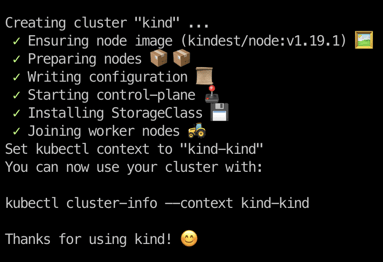
So our cluster is ready, and the next step is deploying the Calico. Here I deploy it using the command:
kubectl create -f https://docs.projectcalico.org/v3.8/manifests/calico.yaml
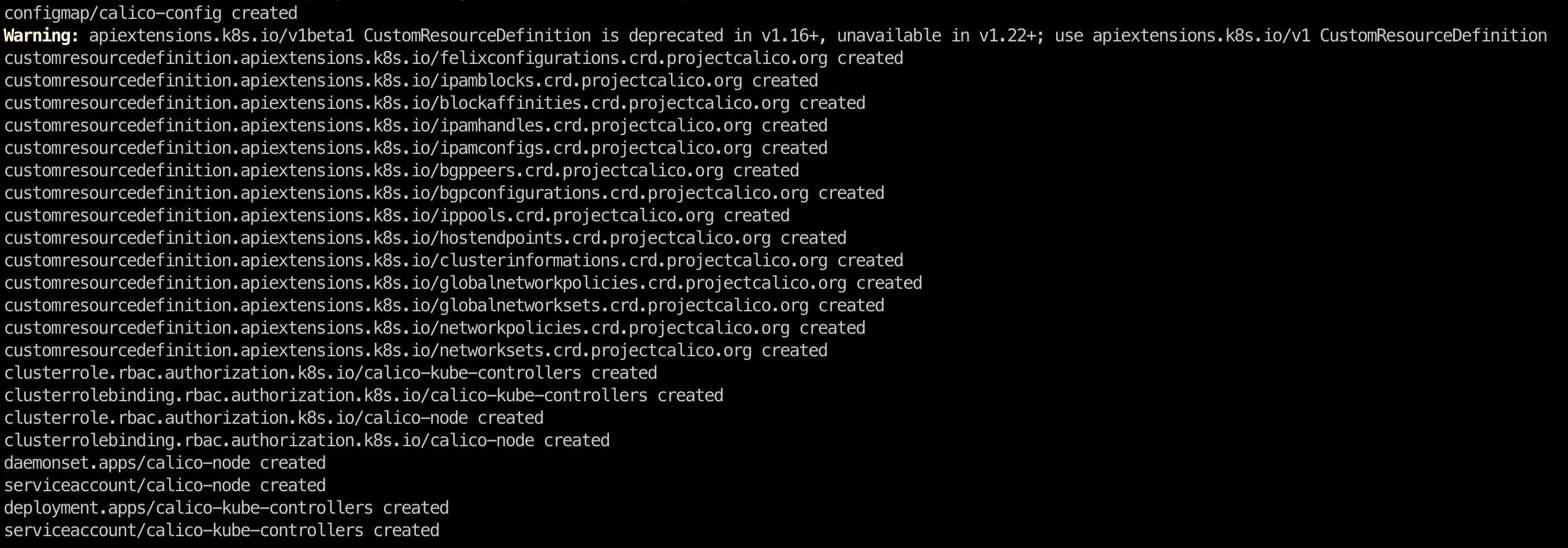
In a couple of minutes, calico pods will be ready.
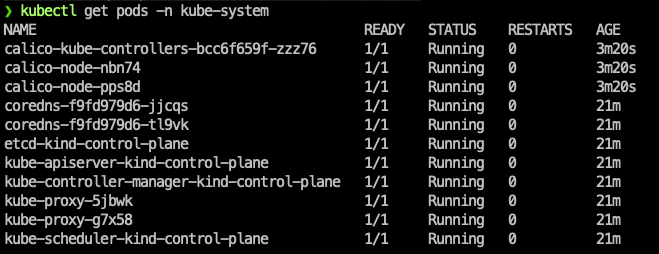
Now we can start to deploy some applications and see how we’ll limit traffic with network policies.
First, let’s remember our architecture. We have four namespaces in our cluster:
- Development
- Frontend
- Backend
- Database
Here, you may think that we have a 3-tier web application stack, and we need to limit traffic between these tiers. Also, we need to deny traffic from the development namespace to our application stack.
So let’s carry on by creating our namespaces and apps.
Here is the manifest file for the namespaces.
apiVersion: v1
kind: Namespace
metadata:
name: development
labels:
env: development
---
apiVersion: v1
kind: Namespace
metadata:
name: frontend
labels:
env: frontend
---
apiVersion: v1
kind: Namespace
metadata:
name: backend
labels:
env: backend
---
apiVersion: v1
kind: Namespace
metadata:
name: database
labels:
env: database
And I create them using the command
kubectl create -f namespace.yaml
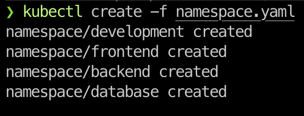
Next, we will deploy our pods and services to test the connection between them and here is the pod.yaml.
apiVersion: v1
kind: Pod
metadata:
name: development-app
namespace: development
labels:
env: development
spec:
containers:
- name: dev-nginx
image: nginx
---
apiVersion: v1
kind: Pod
metadata:
name: frontend-app
namespace: frontend
labels:
env: frontend
spec:
containers:
- name: frontend-nginx
image: nginx
---
apiVersion: v1
kind: Pod
metadata:
name: backend-app
namespace: backend
labels:
env: backend
spec:
containers:
- name: backend-nginx
image: nginx
---
apiVersion: v1
kind: Pod
metadata:
name: database
namespace: database
labels:
env: database
spec:
containers:
- name: db
image: mysql:8.0.23
env:
- name: MYSQL_RANDOM_ROOT_PASSWORD
value: "true"
And here is the service.yaml.
apiVersion: v1
kind: Service
metadata:
name: development-service
namespace: development
spec:
selector:
env: development
ports:
- protocol: TCP
port: 80
targetPort: 80
---
apiVersion: v1
kind: Service
metadata:
name: frontend-service
namespace: frontend
spec:
selector:
env: frontend
ports:
- protocol: TCP
port: 80
targetPort: 80
---
apiVersion: v1
kind: Service
metadata:
name: backend-service
namespace: backend
spec:
selector:
env: backend
ports:
- protocol: TCP
port: 80
targetPort: 80
---
apiVersion: v1
kind: Service
metadata:
name: database-service
namespace: database
spec:
selector:
env: database
ports:
- protocol: TCP
port: 3306
targetPort: 3306
So as you can see, we deploy three nginx containers and a MySQL database container. When they are up and running, we’ll start the tests.
Again I deploy pods and services using the commands below.
kubectl create -f pod.yaml
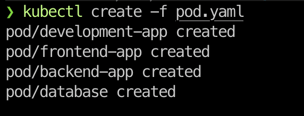
kubectl create -f service.yaml
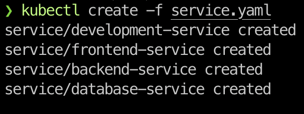
Right now, without any network policies, we can access from any pod to any pod and between all namespaces. This is the default behavior of Kubernetes when you don’t configure network policies. We can directly make some tests and see that we can reach, for example, from the development pod in the development namespace to the MySql database in the database namespace.
Since we are using nginx images in our pods, we can test the connection with the following curl command
kubectl exec -it -n development development-app -- curl telnet://database-service.database:3306 -v
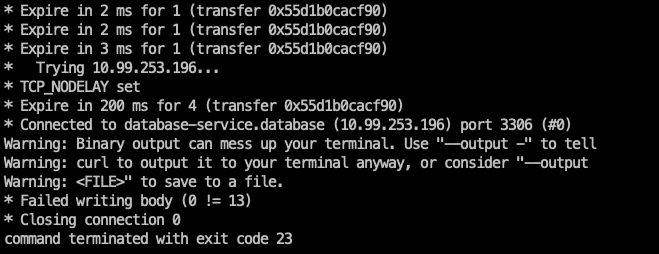
As expected, we can connect to the database without any issue, and it looks scary :). So our next step should be to prevent this and deploy some network policies into our cluster.
A quick overview of network policy
Before deploying a network policy, let’s look at the spec of a network policy.
Like the other objects in Kubernetes, there are the same mandatory fields when defining a network policy. The configuration is set at spec, and here are the fields:
- PodSelector: This is used for selecting the pods to which this NetworkPolicy object applies.
- PolicyTypes: Rule types that our NetworkPolicy relates. We can define "Ingress", "Egress", or "Ingress, Egress" type policies.
- Egress: Outbound traffic control rules to be applied to the selected pods
- Ingress: Inbound traffic control rules to be applied to the selected pods
(We will see more examples and see how these fields are used)
Network policies in action!
First of all, we need to deny everything in all namespaces by default. The reason for this is that we may deploy other namespaces and other resources in our cluster, and we will be able to block the traffic generated by these resources.
So let’s deploy our first network policy.
apiVersion: networking.k8s.io/v1
kind: NetworkPolicy
metadata:
name: default-deny-all
namespace: development
spec:
podSelector: {}
policyTypes:
- Ingress
- Egress
egress:
- ports:
# Allow DNS Resolution
- port: 53
protocol: UDP
- port: 53
protocol: TCP
---
apiVersion: networking.k8s.io/v1
kind: NetworkPolicy
metadata:
name: default-deny-all
namespace: frontend
spec:
podSelector: {}
policyTypes:
- Ingress
- Egress
egress:
- ports:
# Allow DNS Resolution
- port: 53
protocol: UDP
- port: 53
protocol: TCP
---
apiVersion: networking.k8s.io/v1
kind: NetworkPolicy
metadata:
name: default-deny-all
namespace: backend
spec:
podSelector: {}
policyTypes:
- Ingress
- Egress
egress:
- ports:
# Allow DNS Resolution
- port: 53
protocol: UDP
- port: 53
protocol: TCP
---
apiVersion: networking.k8s.io/v1
kind: NetworkPolicy
metadata:
name: default-deny-all
namespace: database
spec:
podSelector: {}
policyTypes:
- Ingress
- Egress
egress:
- ports:
# Allow DNS Resolution
- port: 53
protocol: UDP
- port: 53
protocol: TCP
Let’s see one of them in detail, the database one:
- Namespace: We are deploying this policy in the database namespace
- Podselector: Since we don’t match any label, this network policy will affect all the pods in this namespace.
- PolicyTypes: We use both Ingress and Egress type policies, so no inbound and outbound traffic is allowed
- Egress: We only allow outbound traffic for port 53 and protocol TCP and UDP. This means we can make DNS queries, and we need them to resolve the DNS names for services. Remember, we’ll make curl requests like "curl backend-service.backend"
We’ll deploy these network policies and then make another test as we did previously.
kubectl create -f np-default-deny-all.yaml

Let's do the same test as before to check if we can still access the database.
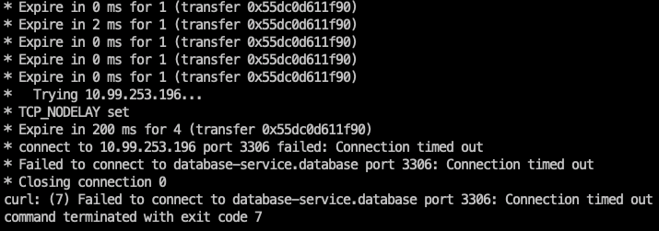
That looks better; we can't connect to the database from the development namespace.
We can carry on with deploying out other network policies. So:
1 - In frontend namespace: We need to allow traffic from frontend to backend, type Egress. (allow-egress-to-backend.yaml)
2 - In backend namespace: We need to allow traffic from frontend to backend, type Ingress. Also, allow traffic from backend to database, type Egress. (allow-ingress-from-frontend-and-egress-to-db.yaml)
3 - In database namespace: We need to allow traffic from backend to database, type Ingress. (allow-ingress-from-backend.yaml)
Let's check the manifest files for each of the network policies
allow-egress-to-backend.yaml
apiVersion: networking.k8s.io/v1
kind: NetworkPolicy
metadata:
name: frontend-network-policy
namespace: frontend
spec:
podSelector:
matchLabels:
env: frontend
policyTypes:
- Egress
egress:
- to:
- namespaceSelector:
matchLabels:
env: backend
podSelector:
matchLabels:
env: backend
ports:
- protocol: TCP
port: 80
allow-ingress-from-frontend-and-egress-to-db.yaml
apiVersion: networking.k8s.io/v1
kind: NetworkPolicy
metadata:
name: backend-network-policy
namespace: backend
spec:
podSelector:
matchLabels:
env: backend
policyTypes:
- Ingress
- Egress
ingress:
- from:
- namespaceSelector:
matchLabels:
env: frontend
podSelector:
matchLabels:
env: frontend
ports:
- port: 80
protocol: TCP
egress:
- to:
- namespaceSelector:
matchLabels:
env: database
podSelector:
matchLabels:
env: database
ports:
- port: 3306
protocol: TCP
allow-ingress-from-backend.yaml
apiVersion: networking.k8s.io/v1
kind: NetworkPolicy
metadata:
name: database-network-policy
namespace: database
spec:
podSelector:
matchLabels:
env: database
policyTypes:
- Ingress
ingress:
- from:
- namespaceSelector:
matchLabels:
env: backend
podSelector:
matchLabels:
env: backend
ports:
- port: 3306
protocol: TCP
We can start deploying these and test them immediately.
kubectl create -f allow-egress-to-backend.yaml
kubectl create -f allow-ingress-from-backend.yaml
kubectl create -f allow-ingress-from-frontend-and-egress-to-db.yaml
Finally, we have deployed all the network policies in our cluster.
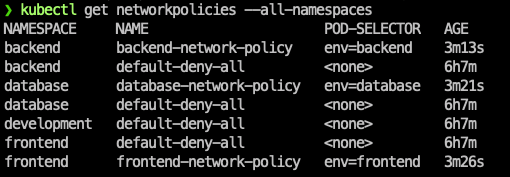
Test time!
I know I'm not able to reach from development namespace to any other so I'll only test the important ones.
Test 1: From frontend to backend
kubectl exec -it -n frontend frontend-app -- curl backend-service.backend
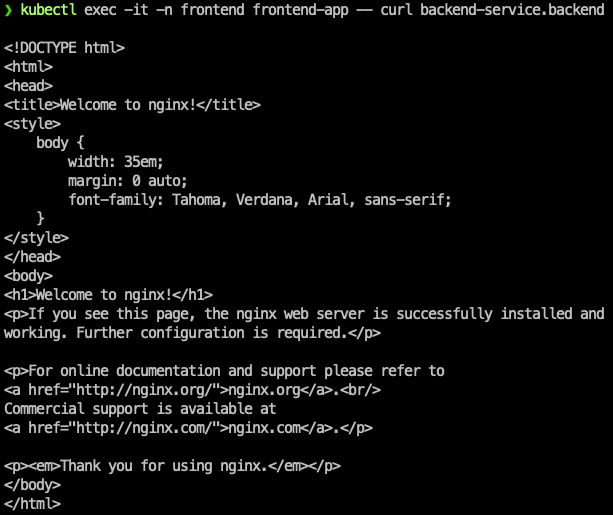
Test 2: From frontend to database. (It should fail)
kubectl exec -it -n frontend frontend-app -- curl telnet://database-service.database:3306 -v
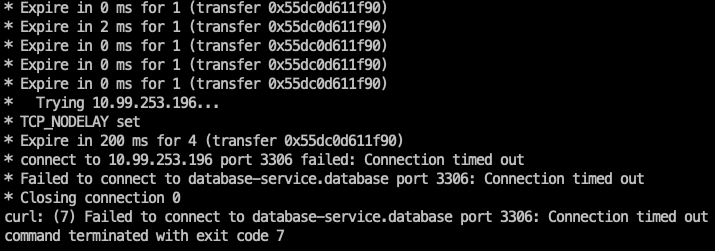
Test 3: From backend to database . (It should work)
kubectl exec -it -n backend backend-app -- curl telnet://database-service.database:3306 -v

That's it, we successfully deployed our network policies, and we can now control our traffic in our Kubernetes cluster. I hope you find it helpful, and if you enjoyed reading it, please don't forget to share.
In our next blog post, we will continue to share other Kubernetes and DevSecOps related information.
We also offer a Free Kubernetes Security Audit; if you’d like to hear more about it, please take a look at it here.
